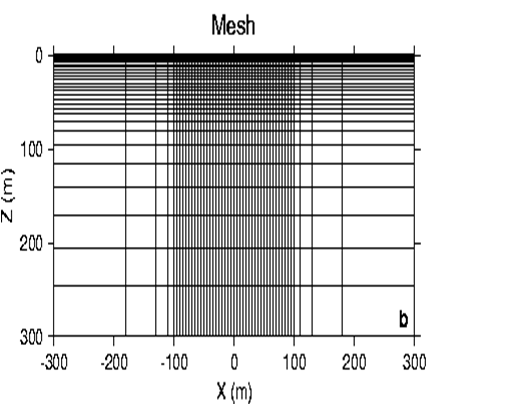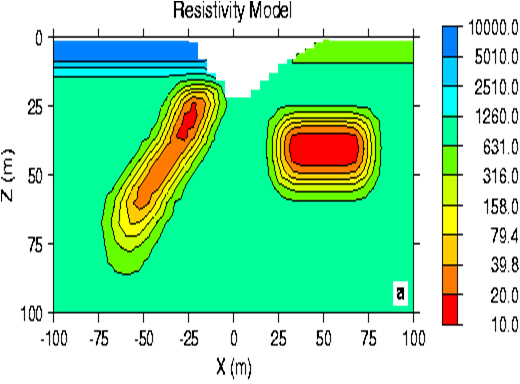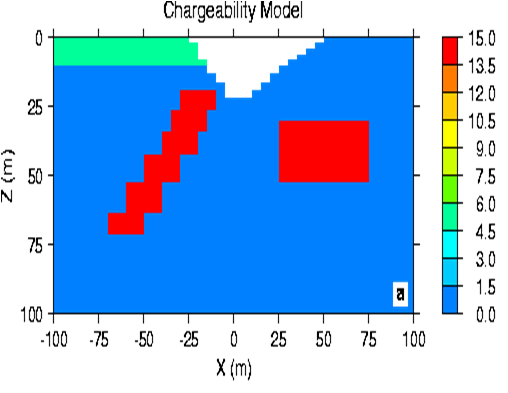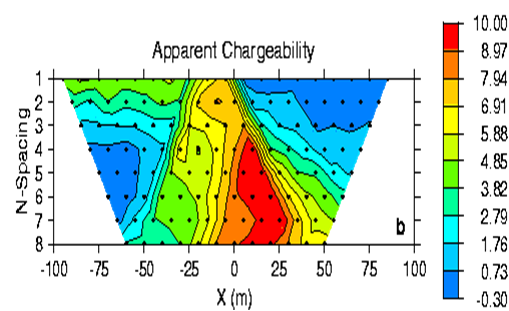6.1. Forward modelling¶

Fig. 6.1 The finite-diffierence mesh used in the modelling.¶

Fig. 6.2 The conductivity model¶
To illustrate the DC resistivity forward modelling algorithm, we generate synthetic data that would be acquired over the 2D conductivity structure. The model is divided into 48 cells in the \(x-\)direction and 27 cells in the \(z-\)direction including a total of 1296 cells. The finite difference mesh is shown in Figure Fig. 6.1.
The model region, shown in Figure Fig. 6.2, consists of a 10 meter thick overburden having conductivity of 0.1 mS/m on the left and 2 mS/m on the right. A V-shaped valley is cut out to simulate the surface topography. Two conductors are buried in the underlying background of 1 mS/m. On the left, a dipping conductor having a dip of 135\(^\circ\) and conductivity of 100 mS/m is buried at a depth of 20 m to the top. On the right, a 50 meter long, 20 meter thick conductive block of 100 mS/m is buried at a depth of 25 meters. Rather than keep the model as discrete blocks we have attempted to make it more geologically realistic by applying a smoothing filter to the model.

Fig. 6.3 The apparent resistivity pseudo-section measured using a pole-dipole array with a = 10 m and n = 1; 8. The data have been contaminated by Gaussian noise.¶
In the survey, surface electrodes are located every ten meters in the interval \(x = (-100, 100)\) meters. We compute the potential differences from a pole-dipole array with the potential electrodes on the right. Our designation for this is PDR (Potential Dipole Right). There are 19 possible current electrode locations and we record the data for each electrode to a maximum \(n-\)spacing of 8. The observed data set consists of 124 potential difference values. It is our intention to use these data as input to an inversion. In order to make them more realistic we contaminate each datum by adding Gaussian noise having a standard deviation equal to 5% of the true potential. The apparent resistivity pseudo-section is shown in Figure Fig. 6.3. That figure can be compared with the conductivity model within the region of interest in Figure Fig. 6.2. There is some manifestation of the horizontal conductive block, but much of the conducting “pants leg” anomaly seen is really the result of the near surface variation of conductivity and topography.

Fig. 6.4 The chargeability model associated with the conductivity model¶
The forward modelling for the IP data is also performed with the program DCIPF2D. To calculate IP data, the program performs two DC forward modelling routines and the IP data are generated by the operations indicated in equation (2.6). For a synthetic example, we choose the chargeability model in Figure Fig. 6.4. It consists of a chargeable layer at the surface with \(\eta = 0.05\) and two chargeable blocks of \(\eta = 0.15\) at depth.

Fig. 6.5 Simulated apparent chargeability data¶
The 124 IP data collected in the survey are also contaminated with Gaussian noise having a standard deviation equal to 5% of the accurate value of the apparent chargeabilites, plus an additional floor of 0.001. The apparent chargeabilities are plotted as percentages in pseudo-section form in Figure Fig. 6.5. There is little manifestation of the chargeable block, which is the target for this inversion, but the user is faced with the difficulty of deciding how much of the high chargeability feature sloping downward to the left is the result of a pant leg from the termination of the surface chargeable block.